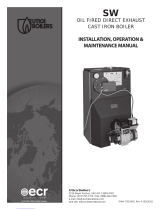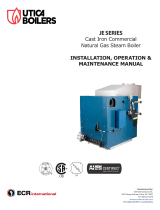
A. Pressure control - on steam boilers - remove cover and note pressure setting. With boiler
operating, decrease the setting. When the setting is lower than boiler pressure, the
control will open, and turn off the boiler. After checking pressure control, reset control
to original setting.
B. Mechanical low water cut-off: Operation may be checked by opening the blow-off valve
on the lower portion of the cut-off body, while the boiler is running. This will drain the
water from the boiler and break the circuit to the burner.
WW
WW
WARNING:ARNING:
ARNING:ARNING:
ARNING: WATER WILL BE BOILING HOT.
Refill boiler to its normal water line.
C. Primary control and flame sensor: To Check:
1. Flame failure - simulate by shutting off oil supply with hand valve while burner is on.
Sixty seconds after flameout, the safety switch locks out, ignition stops, motor stops
and oil valve - when used - closes. To restart, open oil supply valve and reset safety
switch.
2. Ignition failure - with burner off, close oil supply valve and run through start-up
procedure, The safety switch should lock out as in flame failure.
3. Power failure - Turn off main power supply switch while burner is operating. When
burner stops, restore power and burner should start.
If operation is not as described as above, check wiring and controls.
PREVENTIVE MAINTENANCE of an oil fired boiler reduces operating costs. The boiler
and vent pipe should be inspected for accumulation of soot or scale deposits periodically
but at least once every year before the start of each heating season. When soot is present
on the section walls and flueways, improper combustion will result, causing additional
sooting and scaling until flueways are completely closed. To remove soot and scale from
the flueways, remove top jacket panel, top clean-out plate, open burner swing door. (figure
13 on page 12).
INSTRUCTIONS FOR OPENING BURNER SWING DOOR
1. Turn off power to boiler.
2. Allow boiler to cool down.
3. Disconnect power cable at factory supplied burner electrical disconnect. See figure
13 on page 12.
4. Loosen screws on the sides of the lower front jacket panel. See figure 6 on page 6.
Pull the bottom part of the lower front panel forward and lift the lower front panel up and off
the boiler. See figure 13 on page 12.
5. Close oil valve. See figures 10 and 11, on page 9.
6. Disconnect oil line from burner.
7. Do not try to open swing door with oil line attached.
8. Remove nut from swing door stud on right hand side of door.
9. Swing open burner and door to the left.
Using a flue brush, brush the soot and scale into the combustion space where it can be
removed through the swing door opening.
CAUTION:CAUTION:
CAUTION:CAUTION:
CAUTION: USE CAUTION WHEN VACUUMING IN THE CHAMBER
AREA. DAMAGE TO CHAMBER COULD RESULT.
It is recommended to replace the nozzle at the start of each heating season. Lubricate
the burner motor and circulator motor - if required - with a few drops of a good grade of light
motor oil. Do not over oil. Have a competent service person service the burner and check
the controls and check the electrodes for carbon or cracks in the insulators. Burners should
PAGE 14




























